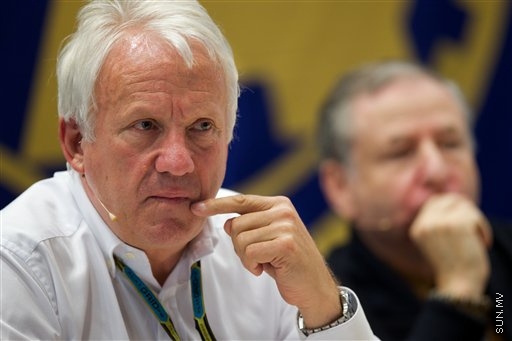
SOCHI, Russia (AP) — Formula One officials are preparing to impose a speed limit to slow down cars during dangerous situations on the track, following the Japanese Grand Prix accident that left driver Jules Bianchi fighting for his life.
Formula One race director Charlie Whiting said Friday it would be best to give teams the ability to cut speed automatically if there is danger on a course, rather than leaving it up to the drivers.
Whiting presented a report on Bianchi's accident to motor sport's governing body on Friday and later joined top officials in briefing reporters.
Whiting said Bianchi had slowed down in his Marussia car before skidding off the wet course in Suzuka and ploughing into a recovering tractor. But not all drivers had slowed down during a double yellow-flag situation and many did not reduce speed a lot. Whiting would not say at what speed Bianchi was traveling at when he lost control.
"Jules slowed down," Whiting said, adding that it was a "matter of degrees" and that more data will have to be studied before his speed could be given with certainty.
With international federation president Jean Todt sitting next to him, Whiting showed previously unreleased video of Bianchi's crash, which shows him driving into the tractor as the marshals had lifted a green flag to signal all clear.
If Bianchi had crashed into a safety tire barrier at the speed he was traveling, he would have escaped serious injury although it would have been a hefty crash, Whiting said.
There was no sign of any mechanical fault with Bianchi's car at this time, he said.
Whiting said the race control did not see that accident immediately because the cameras were pointing in another direction and took about 20 seconds to react.
"Nothing could have been done better," Whiting said of the reaction to Bianchi's accident.
Whiting said he had asked Suzuka organizers to start the race earlier because of heavy rain and fading light but was turned down. He said the time of the start was not a factor in the accident.
The planned speed control would enhance a system already available and would, in some situations, replace the safety car. There was no safety car on the track during Bianchi's accident.
"It's probably better to take the decision to slow down away from the drivers," Whiting said. The aim was to build a "way to control speed with complete certainty and clarity, with the same effect as a safety car."
The idea of the plan, Whiting said, was to slow down to a given and well-known speed at a relevant place." He said it was "easy to do in a small area."
Formula One officials were beginning talks with the teams on Saturday, but Whiting said it would be unrealistic to expect any new systems to be in place before the next season.
Todt, who had requested the report, said he would ask the FIA safety commission, which includes Whiting, to make a study and "proposals so that such an accident never happens again."
Todt is a friend of the Bianchi family and knows the French driver well. Todt's son is Bianchi's agent.
"Motor sport is a dangerous sport, unfortunately," Todt said.